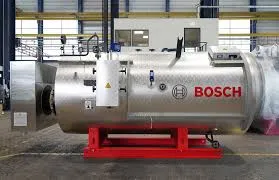
Oct . 31, 2024 15:58 Back to list
Exploring the Three Main Types of Boilers and Their Unique Features
Boilers are essential components of various heating systems and industrial processes, serving the primary purpose of generating steam or hot water. They come in several types, each designed to meet specific needs and applications. In this article, we will explore the three main types of boilers fire-tube boilers, water-tube boilers, and electric boilers.
Fire-Tube Boilers
Fire-tube boilers are one of the oldest types of boilers used in the industry. In these systems, hot gases produced by combustion pass through tubes that are surrounded by water. The heat transfers from the gases to the water, converting it into steam. Fire-tube boilers are typically used for lower-capacity applications as they are generally limited to a maximum pressure of about 300 psi.
One of the main advantages of fire-tube boilers is their simple design and ease of maintenance. They tend to have a lower initial cost compared to other types of boilers, making them an attractive option for small-scale applications. However, they are less efficient than water-tube boilers at high pressures and large capacities.
Water-Tube Boilers
In contrast to fire-tube boilers, water-tube boilers work by circulating water through tubes that are heated by combustion gases. The water is heated to produce steam, which is then utilized for various applications. Water-tube boilers are capable of operating at higher pressures and are often used in large-scale industrial processes, power plants, and commercial heating applications.
what are the 3 types of boiler

One of the key advantages of water-tube boilers is their efficiency and ability to generate steam quickly. They are designed to handle high steam and water pressures, making them suitable for demanding applications. Additionally, their design allows for higher overall heat transfer, which enhances energy efficiency. However, water-tube boilers can be more complex and expensive to install and maintain compared to fire-tube boilers.
Electric Boilers
Electric boilers represent another significant type of boiler, utilizing electricity as the primary energy source. They convert electrical energy into heat, which is then used to produce steam or hot water. Electric boilers are commonly used in applications where traditional combustion fuels are impractical or where there is a need for quiet operation.
The advantages of electric boilers include their compact size, ease of installation, and lower emissions since they do not rely on fossil fuels. They also provide high levels of efficiency and require less maintenance than other types of boilers. However, the primary drawback of electric boilers is their reliance on electricity, which can be a costly energy source in some regions.
Conclusion
In conclusion, understanding the three main types of boilers—fire-tube, water-tube, and electric—is crucial for those in the industry or those considering heating solutions for commercial or residential needs. Each type offers unique advantages and is suited for different applications. The choice of boiler ultimately depends on specific requirements, including efficiency, capacity, and budget. As technology continues to evolve, we can expect further innovations in boiler designs and functionalities to meet the ever-changing energy demands of our society.
-
High-Efficiency Commercial Oil Fired Steam Boiler for Industry
NewsJul.30,2025
-
High-Efficiency Biomass Fired Thermal Oil Boiler Solutions
NewsJul.30,2025
-
High Efficiency Gas Fired Thermal Oil Boiler for Industrial Heating
NewsJul.29,2025
-
High-Efficiency Gas Fired Hot Water Boiler for Sale – Reliable & Affordable
NewsJul.29,2025
-
High Efficiency Biomass Fired Hot Water Boiler for Industrial and Commercial Use
NewsJul.29,2025
-
High-Efficiency Biomass Fired Hot Water Boiler for Industrial Use
NewsJul.28,2025
Related PRODUCTS






















